During the Hindu year, as in all religions, there are many religious days and nights that celebrate a particular Deity or religious event. These times are called festival days, utsavas. You may also hear the term mahotsava meaning “major festival.” Some festivals are considered major and others minor. In general, these days or nights are dedicated as the “birthday” of a particular Deity or the “victory” day when the Deity was triumphant over a particular evil force or demon. In most cases these festivals are named after the lunar days of the Hindu calendar. In general festivals are celebrated during the bright or waxing side of the lunar month (shukla paksha). Festivals that deal with ancestors generally take place during the dark or waning phase of the lunar month (krishna paksha). From the different regions of India there are a seemingly unlimited number of festivals, but here only the major ones that may be celebrated in any Hindu temple outside of India are described. The festival days are listed in the order they are celebrated along with a brief description.
Makara Sankranti
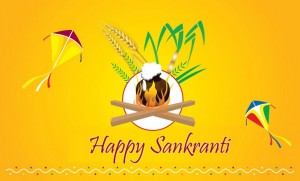 After all the discussion about the Hindu calendar being a lunar calendar, makara sankranti is one of the few major festivals that does not follow the lunar calendar. Instead it is celebrated according to the solar calendar and therefore always falls on the same day in the western calendar, January 14th. Most other Hindu festivals follow the lunar calendar and therefore will vary by approximately three weeks from year to year against the solar calendar. Makara Sankranti is the celebration of the sun beginning its path on the northern course (uttarayana). It is therefore the celebration of the return of light into the world according to the metaphor: the sun equals light, which equals knowledge, and so on. In this regard it is important to note that July 17, which is the beginning of the sun moving on its southern course, is never celebrated or even known. No one celebrates the return of darkness. In different parts of India, Makara Sankranti is celebrated in various ways. It is kite flying day in many parts of India. It is a “rice” harvest festival called Thai Pongal in parts of south India. In the Punjab it is another agricultural festival called Lodi. It is common to see worshippers bringing sweets made with sesame seeds as offering to the Deities in a temple on this day.
After all the discussion about the Hindu calendar being a lunar calendar, makara sankranti is one of the few major festivals that does not follow the lunar calendar. Instead it is celebrated according to the solar calendar and therefore always falls on the same day in the western calendar, January 14th. Most other Hindu festivals follow the lunar calendar and therefore will vary by approximately three weeks from year to year against the solar calendar. Makara Sankranti is the celebration of the sun beginning its path on the northern course (uttarayana). It is therefore the celebration of the return of light into the world according to the metaphor: the sun equals light, which equals knowledge, and so on. In this regard it is important to note that July 17, which is the beginning of the sun moving on its southern course, is never celebrated or even known. No one celebrates the return of darkness. In different parts of India, Makara Sankranti is celebrated in various ways. It is kite flying day in many parts of India. It is a “rice” harvest festival called Thai Pongal in parts of south India. In the Punjab it is another agricultural festival called Lodi. It is common to see worshippers bringing sweets made with sesame seeds as offering to the Deities in a temple on this day.
Maha Shiva Ratri
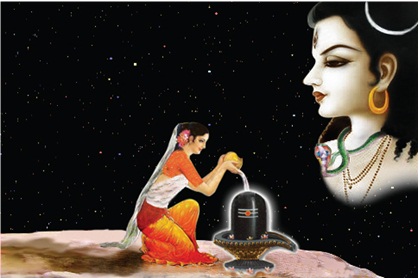 Literally, the “Great Night of Shiva” is celebrated every year on the 13th or sometimes the 14th lunar night (tithi) in the waning or dark fortnight (krishna paksha) of the month of Maagh. This corresponds to late January early February on the solar calendar. There are many stories to explain the source of this important festival, but in essence it is a night set aside for worship and remembrance of Shiva. During this night there are elaborate pujas and abhishekas (bathing ceremonies) to the Shiva Linga that include offerings of special (Bilva) leaves. It is a day of fasting and a night of bhajans and prayer.
Literally, the “Great Night of Shiva” is celebrated every year on the 13th or sometimes the 14th lunar night (tithi) in the waning or dark fortnight (krishna paksha) of the month of Maagh. This corresponds to late January early February on the solar calendar. There are many stories to explain the source of this important festival, but in essence it is a night set aside for worship and remembrance of Shiva. During this night there are elaborate pujas and abhishekas (bathing ceremonies) to the Shiva Linga that include offerings of special (Bilva) leaves. It is a day of fasting and a night of bhajans and prayer.
Holi
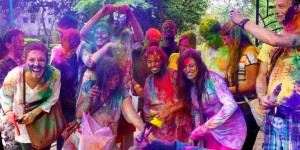 Also known as the Festival of Colors or even the Mardi Gras of Hinduism, Holi traditionally takes place over two days in late February or early March on the full moon day of the month of Phalgun. Holi is a popular spring festival observed particularly in North India that includes a bonfire and the throwing of colored powders. On the first day there is a bonfire which represents the burning the demoness, Holika.
Also known as the Festival of Colors or even the Mardi Gras of Hinduism, Holi traditionally takes place over two days in late February or early March on the full moon day of the month of Phalgun. Holi is a popular spring festival observed particularly in North India that includes a bonfire and the throwing of colored powders. On the first day there is a bonfire which represents the burning the demoness, Holika.  It is the triumph of good over evil. On the second day colored powders, red, blue, yellow, green, white, are exchanged between the participants along with hugs and smiles. In the west the two days are usually merged into one afternoon or evening. It is a joyous festival as you can see from the photo.
It is the triumph of good over evil. On the second day colored powders, red, blue, yellow, green, white, are exchanged between the participants along with hugs and smiles. In the west the two days are usually merged into one afternoon or evening. It is a joyous festival as you can see from the photo.
Ugadi
Ugadi falls on the first day of the bright half of the month of Chaitra and it marks the beginning of the new year for much of South India including the states of Maharasthra, Karnataka and Andra Pradesh. The word ugadi is derived from the Sanskrit “yuga-adi” which means, “beginning of the yuga.” Here yuga means the beginning of the year. In Maharastra the day is called Gudi Padwa. In general Ugadi is celebrated more as a cultural event and less as a religious event.
Hanuman Jayanti
Hanuman Jayanti is a festival to celebrate the birth of Hanuman the famous “monkey” Deity worshipped throughout India. Hanuman Jayanti is celebrated during the month of Chaitra (March/April) to venerate Hanuman who was an ardent devotee of Rama. Hanuman is the embodiment of strength, energy and resourcefulness. He is able to assume any form at will, wield rocks, move mountains, jump through the air, and even hides in clouds. In folk tradition he is a deity with magical powers who has the ability to conquer evil spirits. During Hanuman Jayanti devotees visit temples and apply markings (tika) of reddish powder (sindhur) to their foreheads. This is considered to be good luck. According to the legend, while Sita, the wife of Rama, was applying sindhur to her head, Hanuman asked her why, and she replied that this would ensure a long life for her husband. Hanuman then smeared his entire body with sindhur to ensure Rama’s immortality. For this reason you often see Hanuman covered in a particular orange kind of powder. Religious programs are organized in most Hindu temples and on this day Hanuman Jayanti is often celebrated with the recitation of the Hanuman Chalisa, forty verses praising Hanuman taken from the Ram Charit Manas. This chalisa may be recited 108 times taking many hours.
Guru Purnima
The day of full moon in the month of Aashadh in the Hindu Calendar is traditionally celebrated as Guru Purnima by many Hindus. On this day devotees offer worship (puja) to their guru. According to tradition this was the day when Vyasadeva, author of the Mahabharata and the Puranas, was born. All religious teachers (gurus) are revered on this day by remembering their life and teachings.
Vara Lakshmi
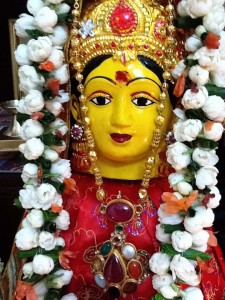
Vara Lakshmi puja is a special time when married ladies worship Lakshmi Devi, the consort of Vishnu and the embodiment of beauty, prosperity and wealth. The Vara Lakshmi puja is performed during the month of Shraavan (corresponding to August – September) on the Friday immediately following the full moon day (purnima). This festival is primarily followed within the south Indian community and is performed by married ladies to ensure wealth, good progeny, good health, and long life for their husbands.
Janmasthami
Krishna Janmashtami, also known as Gokulashtami, Shri Krishna Jayanti, or sometimes just Janmasthami is a festival celebrating the appearance of Lord Krishna, the eighth incarnation (avatara) of Vishnu. Literially janma means birth and ashthami means eighth.
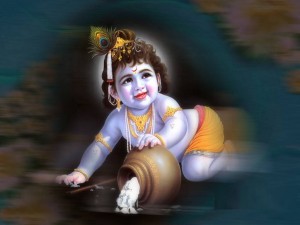 Krishna Janmashtami is observed on the eighth lunar day of the dark half of (krishna paksha) the month of Shraavan when the rohini nakshatra is rising. There is often confusion regarding the right day to celebrate Jamnasthami because both calendar requirement do not always coincide perfectly and because calendars may be prepared for different parts of the world, Consequently, it is common to find different temples celebrating the festival a day apart.
Krishna Janmashtami is observed on the eighth lunar day of the dark half of (krishna paksha) the month of Shraavan when the rohini nakshatra is rising. There is often confusion regarding the right day to celebrate Jamnasthami because both calendar requirement do not always coincide perfectly and because calendars may be prepared for different parts of the world, Consequently, it is common to find different temples celebrating the festival a day apart.
The festival falls in the months of August/September of the western calendar. Janmasthami is always celebrated with puja and a bathing ceremony for baby Krishna and it usually lasts until midnight, the time when Krishna appeared on earth. At midnight a special aarti takes place and sweets are thrown from the altar as a prasada.
Ganesha Chathurthi
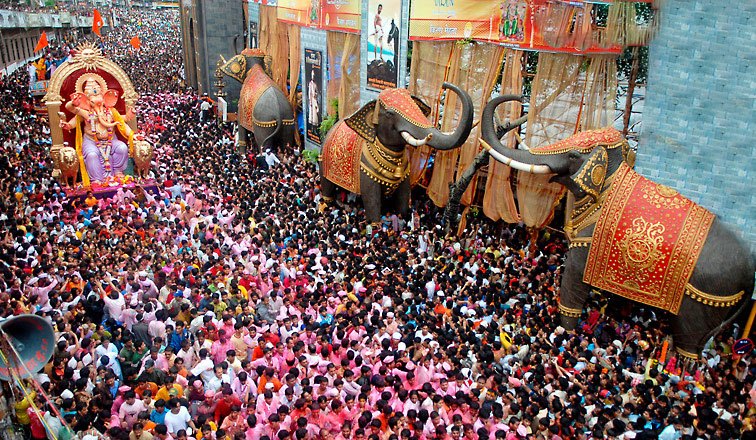 Ganesh Chaturthi is the festival day when Ganesha, the son of Shiva and Parvati, first appeared for all his devotees. The day is also known as Vinayaka Chaturthi and it is observed in the month of Bhadrapada starting on the fourth lunar day (chathurthi) of the waxing moon.
Ganesh Chaturthi is the festival day when Ganesha, the son of Shiva and Parvati, first appeared for all his devotees. The day is also known as Vinayaka Chaturthi and it is observed in the month of Bhadrapada starting on the fourth lunar day (chathurthi) of the waxing moon.
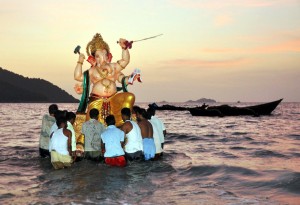 This always comes between late August and early September. Traditionally the festival lasts for 10 days, but in most Hindu temples in the West, the festival is generally celebrated for just one day. Ganesha is widely worshipped as the supreme Deity of wisdom, prosperity and good fortune. Most Hindus will begin any puja or important event with the invocation of Ganesha.
This always comes between late August and early September. Traditionally the festival lasts for 10 days, but in most Hindu temples in the West, the festival is generally celebrated for just one day. Ganesha is widely worshipped as the supreme Deity of wisdom, prosperity and good fortune. Most Hindus will begin any puja or important event with the invocation of Ganesha.
Shraaddha/Pitri Paksha
Shraaddha is a Sanskrit word which literally means “based on faith.” A shraaddha therefore is a ritual based on faith. Of course, all rituals are shraaddhas in the widest sense of the term, but specifically a shraaddha denotes a ritual performed to pay homage to one’s deceased ancestors (pitri), and especially to one’s deceased parents during the dark fortnight (krishna paksha) of the month of Bhadrapada (September/October). For this reason the dark fortnight of this month is also called the Pitri Paksha.
Performing a shraadha is a way of expressing one’s gratitude and thanks to parents and ancestors. The shraaddha period lasts for two weeks and includes every lunar day (tithi) as well as a new and full moon. In other words, it covers all the possible lunar times when a person could pass away. This means if an ancestor had passed away on the 4th lunar day of any month, whether waxing or waning, that person’s shraaddha could be observed on the 4th lunar day of the pitri paksha period. If the person passed away on the 8th lunar day of any month, his shraaddha would be observed on the 8th lunar day of the pitri paksha period, and so on. The rituals used to observed a shraaddha will involve the pouring of water, a sacred fire (havan) and the feeding of priests and other honored guests in one’s home.
Nava Ratri
Nava means “nine” and “ratri” means “night,” so the Nava Ratris is a festival held for nine nights. There are two Nava Ratris cycles in each year, one in the spring and one in the fall. The spring Nava Ratris occur during the first nine lunar nights of the bright fortnight of the month of Chaitra. This corresponds to March-April on the Western calendar. The fall Nava Ratris occur during the first nine lunar nights of the bright fortnight of the month of Aasvini. This corresponds to September/October on the Western calendar. The fall Nava Ratris are more popular, but both Nava Ratris are a time of fasting, purification and spiritual renewal. Traditionally, the Nava Ratris are an auspicious time for starting new ventures such as moving into a new home or starting a business.
The fall time Nava Ratris especially focus on the worship of Devi in all her forms. Here is a nice interpretation of the fall season Nava Ratris.
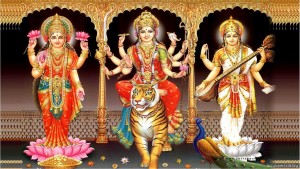 The nine nights are divided into three sets of three nights each to adore three different aspects of the Goddess. On the first three nights the Goddess Durga is invoked as a spiritual force to destroy all impurities, vices and defects. On the second set of three nights the Goddess Lakshmi is adored as the giver of spiritual wealth. The final set of three nights is spent in worship of the Goddess Sarasvati, who is the embodiment of wisdom. In order to have full success in life, believers seek the blessings of all three aspects of the Goddess, who first destroys impurities from the heart, then endows the worshipper with spiritual powers, and finally gives the maturity of wisdom to know how to employ these great powers. Hence the nine nights of worship. Most common of all is the traditional Ras Garba dances that are performed during these Nava Ratris, This dance is traditionally a Gujarati custom, but it is quickly becoming the main focus of the Nava Ratri celebrations in the West.
The nine nights are divided into three sets of three nights each to adore three different aspects of the Goddess. On the first three nights the Goddess Durga is invoked as a spiritual force to destroy all impurities, vices and defects. On the second set of three nights the Goddess Lakshmi is adored as the giver of spiritual wealth. The final set of three nights is spent in worship of the Goddess Sarasvati, who is the embodiment of wisdom. In order to have full success in life, believers seek the blessings of all three aspects of the Goddess, who first destroys impurities from the heart, then endows the worshipper with spiritual powers, and finally gives the maturity of wisdom to know how to employ these great powers. Hence the nine nights of worship. Most common of all is the traditional Ras Garba dances that are performed during these Nava Ratris, This dance is traditionally a Gujarati custom, but it is quickly becoming the main focus of the Nava Ratri celebrations in the West.
Durgashtami
“Durga” refers to the Goddess Durga and “asthami” means 8th. Thus Durgasthami is the worship of the Goddess Durga Devi on the 8th lunar day during both the spring time and fall time Nava Ratris. Naturally, Durgasthami is always celebrated on the 8th day of the 9 night Nava Ratri festival. Commonly a special havan or fire worship ceremony is performed on that day. This is the day when Durgadevi killed the great buffalo demon, Mahishasura.
Vijaya Dashami
Also known as Dussehra, Vijaya Dashami is the celebration of Rama’s victory over the demon Ravana. The story of Rama’s killing of Ravana is found in the Ramayana. Vijaya means victory and dashami means tenth and so Vijaya Dashami is the victory on the 10th lunar day. If the Nava Ratris are a time of purification and the attainment of spiritual powers and wisdom, the Vijaya Dashami celebration, which follows the day after the last Nava Ratri in the fall is the culmination of that time of purification with the final conquering of evil symbolized by Rama’s killing of Ravana. Commonly an effigy of Ravana is burnt when a flaming arrow is shot into Ravana’s heart by a devotee dressed up like Rama.
Diwali, Festival of Light
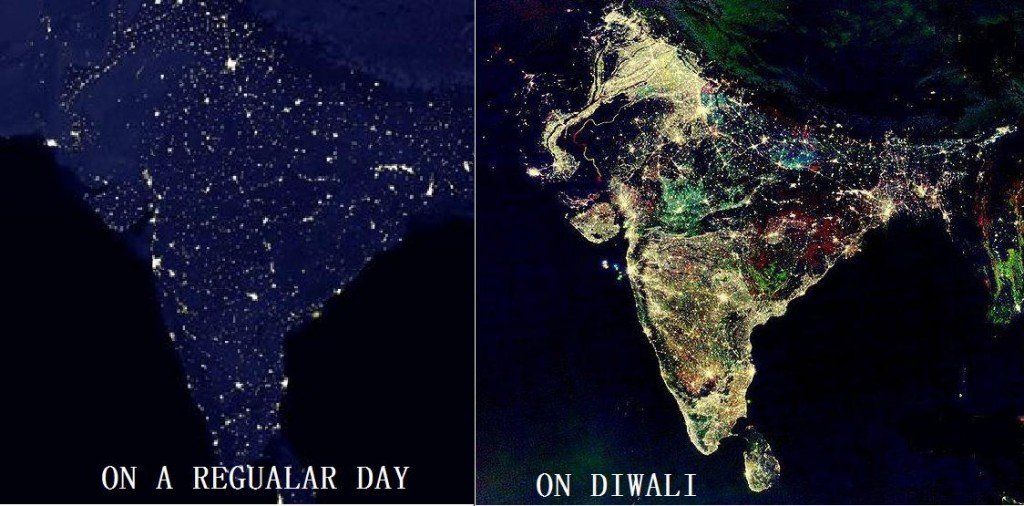 In Sanskrit Diwali is written as dipavali, “dipa” is a lamp and “avali” means a row. So dipavali is literally a row of lamps. Today in many Western countries Diwali has become famous as The Festival of Lights. Similar to Christmas in terms of lights, Hindus will string lights around their houses and temples. Diwali is always celebrated on the new moon night at the end of the month of Aashwini. There are numerous interpretations regarding the origins of this famous festival, but the one I prefer connects to the Nava Ratri and Vijaya Dashami festivals. After killing Ravan on the 10th lunar day (Vijaya Dashami), Rama returns to Ayodhya, his capital, on the following new moon (amavashya) night. Diwali comes exactly twenty days after Vijaya Dashami. Since there is no moon on that day, the residents of Ayodhya are said to have illuminated the city by placing lamps on their homes and other building eager for Rama’s return. Hence the name Diwali. Other interpretations have to do with Krishna defeating the demon Narakasura, or in honor of the day Bali went to rule the nether-world according to the order of Vishnu. In all cases Diwali is the celebration of good conquering evil and the bringing of light back into the world. On the day of Diwali, many devotees wear new clothes, share sweets and snacks, and light firecrackers. Some North Indian business communities start their financial year on Diwali and so open their new business books on this day.
In Sanskrit Diwali is written as dipavali, “dipa” is a lamp and “avali” means a row. So dipavali is literally a row of lamps. Today in many Western countries Diwali has become famous as The Festival of Lights. Similar to Christmas in terms of lights, Hindus will string lights around their houses and temples. Diwali is always celebrated on the new moon night at the end of the month of Aashwini. There are numerous interpretations regarding the origins of this famous festival, but the one I prefer connects to the Nava Ratri and Vijaya Dashami festivals. After killing Ravan on the 10th lunar day (Vijaya Dashami), Rama returns to Ayodhya, his capital, on the following new moon (amavashya) night. Diwali comes exactly twenty days after Vijaya Dashami. Since there is no moon on that day, the residents of Ayodhya are said to have illuminated the city by placing lamps on their homes and other building eager for Rama’s return. Hence the name Diwali. Other interpretations have to do with Krishna defeating the demon Narakasura, or in honor of the day Bali went to rule the nether-world according to the order of Vishnu. In all cases Diwali is the celebration of good conquering evil and the bringing of light back into the world. On the day of Diwali, many devotees wear new clothes, share sweets and snacks, and light firecrackers. Some North Indian business communities start their financial year on Diwali and so open their new business books on this day.
Annakuta
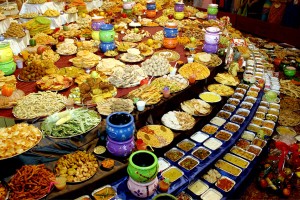 Annakuta generally takes place the day following Diwali. “Anna” means food and kutameans a “mound,” so literally Annakuta is a “mound of food.” The festival is celebrated in temples as members bring food offerings that are added to a growing number of dishes used to decorate an altar. Sometimes the festival is connected to another festival called Govardhana Puja, which celebrates the day Shri Krishna lifted the mountain known as Govardhana. In this case the great “mound of food” becomes Govardhana mountain. Usually the festival includes a Krishna puja, bhajanas, a telling of the story of Krishan lifting Govardhan mountain and arati.
Annakuta generally takes place the day following Diwali. “Anna” means food and kutameans a “mound,” so literally Annakuta is a “mound of food.” The festival is celebrated in temples as members bring food offerings that are added to a growing number of dishes used to decorate an altar. Sometimes the festival is connected to another festival called Govardhana Puja, which celebrates the day Shri Krishna lifted the mountain known as Govardhana. In this case the great “mound of food” becomes Govardhana mountain. Usually the festival includes a Krishna puja, bhajanas, a telling of the story of Krishan lifting Govardhan mountain and arati.
Lakshmi /Chopra Puja
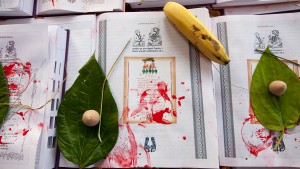
Lakshmi puja is celebrated as part of the Diwali festival and is similar to Vara Lakshmi puja except that it is celebrated by all devotees and not just married ladies. Lakshmi Devi is the Goddess of wealth and prosperity, and so it is common for devotees to perform Lakshmi puja with gold or silver coins, jewelry, or a small sacred image of Lakshmi as the Goddess Lakshmi herself. Milk, yogurt, honey, ghee, sugar (panchamrita) and other liquids are liberally poured over the coins, jewelry or murti in an elaboarate bathing ceremony of Lakshmi Devi. There is a related puja that is performed by business people at this time called Chopra Puja. Chopra refers to “business books,” and so during this season business people bring their check-books or even laptop computers to a priest to have Lakshmidevi worshipped over their business books.
Sometimes we think of the time of the year from Janmasthami until Diwali as puja season because many important festivals that include Ganesha Chaturthi, Shraaddha, the Nava Ratris, Vijaya Dashami, and Lakshmi puja cluster between these months.
Ekadashi
“Eka” means one and “dasha” means ten, therefore, eka + dasha= eleven. Eleven refers to the 11th lunar day of both the waxing and waning lunar month. Thus there are two ekadashis each month. Generally these days are observed as fasting days and they are observed by the most pious twice a month throughout the year as a day of prayer and meditation. Each of the ekadashis has a separate name. The two most common ekadashis are thevaikuntha ekadashi (celebrated in December/January) which is a famous Balaji festival, and the nirjala ekadashi.Nirjala means “without water” and so this ekadashi is ideally followed by total fasting including not even the taking of water. It is said that if one can follow just one ekadashi in the year this should be the one. Other pious Hindus may also fast on Mondays in honor of Shivaji or on Tuesdays in honor of Hanumanji.
Kalyanam
This is a particular type of puja that is most popular within the South Indian community. It is a divine wedding ceremony that is performed primarily on festival days. The word kalyana literally means “the beautiful” and what can be more beautiful than a divine wedding; hence the meaning of the term. Some examples of this ceremony include Rama Kalyanam, the wedding of Sita and Rama especially performed on the festival day of Rama Navami, another is the Shiva Kalyana the wedding of Shiva and his wives performed on Shiva Ratri and the Balaji Kalyana, the wedding of Balaji and his wives performed on important Balaji dates such as Vaikuntha ekadashi. Usually during the performance of a Kalyanam ceremony, two or more families get together and play the role of the bride’s and groom’s parents. A mandapa, the place where weddings are performed, is decorated and many of the mantras that are ordinarily recited in wedding are chanted. It is a enjoyable and exciting ceremony.